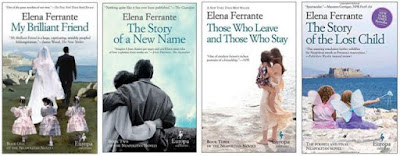Ferrante herself is a mystery woman. No one knows who she is, what she looks like, or where she lives. This in itself, in an age of massive media attention to every big new thing, is remarkable and might reasonably be perceived as a sort of media blitz of its own (search "Elena Ferrante's identity" and you get over 100,000 results). Everyone is speculating, guessing, even claiming to have found her. If she remains elusive, it will be a marvel.
So, what do I think of the quartet halfway in? I'd have to say I like them, I dislike them, and I can't seem to put them down. Ferrante creates an exquisitely detailed world that spans decades and brings Naples to life politically and culturally. The story line follows the friendship of two Neapolitan girls born just after World War II. They're five or six as My Brilliant Friend begins and about twenty as the second novel, The Story of a New Name, concludes (they'll be going on seventy by the end of the series).
Elena and Lila were born in the same poor, violent neighborhood in Naples, where husbands beat wives, brothers beat sisters, parents beat kids, and the typical hissed threat is "Do that again and so help me God I will kill you." At that time in Italy, feminism wasn't a concept nor was divorce legal; the lives of many Italian women were bleak. Many men's lives weren't so great either.
Elena, the studious good girl, and Lila, the rebel, are both unusually bright but only Elena completes high school and even goes on to college. Over the years the girls' friendship waxes and wanes, sometimes breaking off tumultuously. Events play out within a large cast of neighborhood characters: family members, schoolmates, boyfriends, teachers, parents, shopkeepers, and the notorious Solara family, linked to the Camorra (Neapolitan organized crime), whose members control the neighborhood through loansharking, extortion, threats, beatings, and even murder.
It's not the novels' gritty setting with its violence and corruption that, at times, turns me off. It's the wildly unpredictable nature of Elena and Lila's friendship. At times Lila's a true-blue friend and at other times she behaves in unpredictable, despicable, and cruel ways. She hurts Elena again and again. Of course, it can certainly be said that she hurts herself more. Elena gets in a few licks too, at one point dumping a box of Lila's journals, painstakingly written over the years and entrusted to Elena's care, into the Arno River. Their breaches can make for tough reading.
Reviewing this series in the Financial Times, the novelist Claire Messud wrote, "I end up thinking that the people who don't see Ferrante's genius are those who can't face her uncomfortable truths: that women's friendships are as much about hatred as love . . . ." I guess I can't -- or don't -- accept that particular "truth," but I also can't stop reading the novels; I'm just about to start book three, Those Who Leave and Those Who Stay. Ferrante has created a series that's powerfully compelling. And, in the end, maybe my love/hate relationship with it is fitting. After all, Lila and Elena love and hate each other for over sixty years. Maybe I'm just not Neapolitan enough to get it.
~Ann, Adult Services

No comments:
Post a Comment